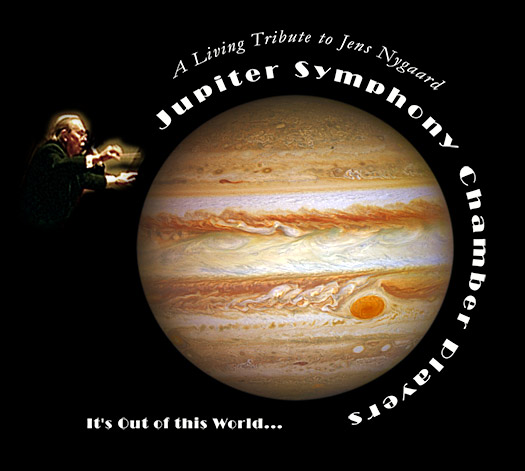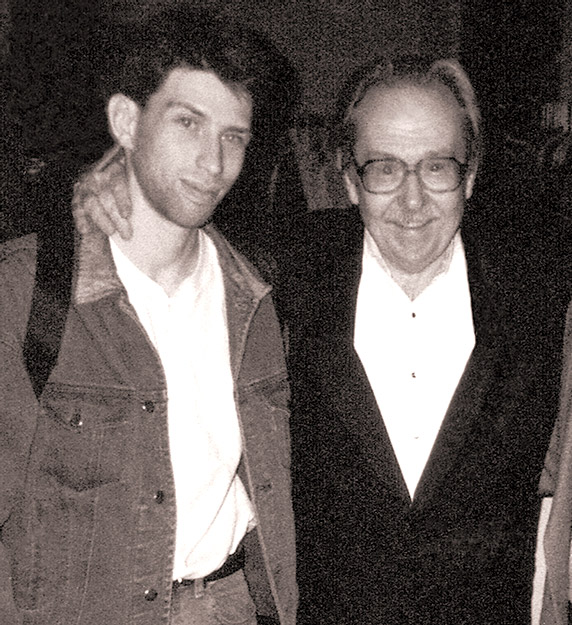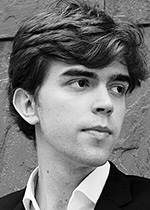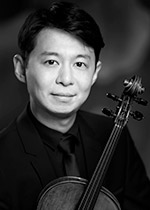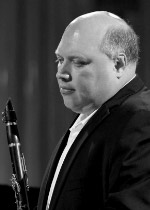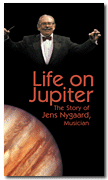Join us for our next concerts...
Jupiter ~ Summer 2025
Monday, June 16 ♦ 2 PM & 7:30 PM
Au Conservatoire de Paris
Good Shepherd Presbyterian Church
152 West 66 Street (west of Broadway)
Limited Seating
Tickets: $25, $17, $10 ~ Reservations advised
Call (212) 799-1259 or email admin@jupitersymphony.com
Pay by check or cash (exact change)
Albert Cano Smit piano
Winner in the 2019 Young Concert Artists Auditions, First Prize at the 2017 Naumburg Piano Competition and finalist and CMIM grant recipient of the 2017 Concours International Musical de Montréal ~ “a superb musician has spoken” Le Devoir
Danbi Um violin
Top prize in the 2018 Naumburg competitions; Recipient of the 2018 Salon di Virtuosi Career Grant; Winner of the 2015 Astral Artists Auditions; Silver Medalist in the Menuhin and Michael Hill competitions ~ “...utterly dazzling” The Strad ~ “a marvelous show of superb technique” and “mesmerizing grace” New York Classical Review
Cherry Yeung violin
Winner of many first and top prizes—at the 2018 Hudson Valley Philharmonic and 2013 Schoenfeld string competitions, the 2017 Juilliard Violin Concerto, and 2014 and 2015 Hong Kong Academy Concerto competitions ~ in 2018 she was also named a New York Philharmonic Global Academy Zarin Mehta Fellow
Cong Wu viola
Assistant Principal Violist of the New York Philharmonic, won 3rd Prize in the 14th Primrose Viola Competition and a Special Prize in the 12th Lionel Tertis Competition
Gaeun Kim cello
Among her honors are the 2023 New York Young Artist Award, first prize and Pablo Casals special award at the 2022 Irving Klein competition, first and audience prizes at the 2022 Washington competition, first prize at the 2015 David Popper and 2014 Liezen competitions, and first prize and special award at the 2012 Antonio Janigro Competition
Sooyun Kim flute
Winner of the Georg Solti Foundation Career Grant and a top prize at the ARD flute competition, she has been praised for her “vivid tone colors” by the Oregonian and as a “rare virtuoso of the flute” by Libération
Vadim Lando clarinet
Winner of the CMC Canada, Yale and Stonybrook competitions ~ “consistently
distinguished...vibrant, precise, virtuosic playing” The New York Times
Note: Danbi Um replaces Njioma Grevious for this concert
The 5 composers, whose music is featured on the program, studied and/or taught at the Paris Conservatory, founded in 1795. Devienne was professor from 1795 to 1803. Dancla began his music studies there in 1828; Saint-Saëns and Ravel matriculated at ages 13 and 14, respectively; and Henri Rabaud, in 1893, and became its director in 1920.
François DEVIENNE Flute Quartet in A minor Op. 66 No. 1
~ an elegant, graceful, and engaging piece by the first flute professor of the Paris Conservatoire
Born in Joinville in 1759, the brilliant flautist and virtuoso bassoonist, known as the “French Mozart,” was also a prolific composer. A workaholic, he composed 8 hours a day, performed regularly, taught, and compiled an influential treatise for playing the flute. Well known in his day, Devienne’s compositions raised the level of writing for wind instruments in France in the late 18th century. His works for flute, the fashionable instrument of the day, were revived by Jean-Pierre Rampal in the 1960s. Of his operas, Les visitandines (1792), among the most successful of the Revolutionary period, had a 5-year run of over 200 performances in Paris. In demand as a musician, Devienne was a bassoonist in the Paris Opéra orchestra, a member of the famous Loge Olympique during the 1780s after he became a freemason in 1781, and appeared numerous times both in solo concertos and symphonies concertante at the Concert Spirituel. After he joined the military band of the Paris National Guard in 1792, he taught at its Free School of Music, which became the National Institute of Music in 1793, and then the Paris Conservatoire in 1795. His famous Nouvelle méthode for the one-key flute, which includes interesting articles on the technique and style of the time, was published in 1794 and widely used. Devienne died in 1803 at Charenton, a Parisian asylum for the mentally ill, his faculties impaired.
Charles DANCLA String Quartet No. 8 in G Major Op. 87
~ pyrotechnics abound in this Gold Medal winner of the Société Sainte Cécile of Bordeaux’s music competition, influenced by his deep admiration of Paganini and Vieuxtemps
The quartet is a fine work with passages of rich string sonorities, a joyful and bright minuet, a sublime slow movement, and a bravura finale of perpetual motion. It was dedicated to his friend and compatriot François Soubies, a French politician of the extreme left wing group of the Montagne.
Dancla (1817–1907) came from a talented French family of musicians; his 2 brothers played the violin and cello, and his sister, the piano. He attended the Paris Conservatoire from 1828 to 1840 and won a premier prix in 1833; his school mates included Charles Gounod and Cèsar Franck. Performances by Pierre Baillot (one of his teachers) of quartets by Boccherini, Haydn, Mozart, and Beethoven sparked his interest in chamber music, prompting him to form his own group, together with his siblings. Their concerts at the home of the postman Hesselbein were a regular feature of the Paris season. In 1842, he failed to secure the sought-after post of principal professor of violin at the Conservatoire. Six years later, still dispirited, he left Paris to work in postal jobs, first in Cholet, then in Paris. In 1855, however, he was finally offered a position at the Conservatoire and five years later, became professor of violin, a post he held until he unwillingly retired in 1892. As a violinist Dancla was praised for his trill, lightness of bowing, and his brilliance. The New Grove Dictionary gives a summary of other achievements: “He was highly respected at the Conservatoire as a person, musician and teacher.... He was a prolific composer and won prizes for four of his 14 string quartets and three of his works for male chorus; but it is only through his didactic works that his music survives.... He may be regarded as the last exponent of the classical French school of violin playing.”
Maurice RAVEL Piece en Forme de Habanera
~ based on a Cuban contradanza arranged for clarinet and piano by Gaston Hamelin
In March 1907 Ravel received a commission from Amédée-Louis Hettich, a singer and teacher at the Paris Conservatoire intending to compile a repertoire of vocal exercises by contemporary composers. Thus, the Vocalise-Étude en forme de habanera for mezzo-soprano and piano was composed. Together with contributions from Vincent d’Indy, Paul Dukas, Reynaldo Hahn, and others, the Répertoire moderne de vocalises-études was published by Alphonse Leduc in 1909. Ravel’s song was premiered by Magdeleine Greslé and Marcel Chadeigne in a concert of the Société Nationale de Musique on 22 February 1919 at the Salle de la Société des Concerts. The piece became better known in his instrumental arrangement as Pièce en forme de habanera—a song without words.
Bru Zane Mediabase notes, “In character and rhythm it recalls the Habanera written in 1895 that appeared as one of the two movements of his Sites auriculaires for two pianos and was later included as the penultimate movement of the orchestral Rapsodie espagnole (1907). Playing ‘almost slowly and with indolence,’ the left hand presents the ostinato that is typical of this dance, which French musicians believed to be Spanish although it in fact originated in Cuba. Melodic elements combining binary and ternary rhythms, and vocal melismas, measured or cadential (the latter marked ‘rubato’), are superimposed in the piece. Ravel’s Spanish inspiration was quite free, with some of the ornamental formulas calling to mind rather an imaginary East. As for the modal harmonies, they bear Ravel’s signature, with hardly any borrowings from the oral traditions of the Iberian Peninsula. They subtly articulate the minor colourings that dominate at the beginning of the piece, and the predominance of major sonorities in the final episode.”
Ravel studied at Conservatoire de Paris from age 14, from 1889 to 1905, when he failed in his fifth attempt to win the Prix de Rome. “Ravel failed the preliminaries, summarily ending his already checkered career at the Conservatoire. Aspersions were cast in every direction as the pundits spun their tales and explanations; Gabriel Fauré’s accession as director after the unexpected resignation of Théodore Dubois was widely understood as a turn to the outside for someone to rescue a fading enterprise. But in fact Dubois had decided to resign well before the prize competition, and Ravel’s two principal detractors at the Academy, Charles Lenepveu and Émile Paladilhe, held scant claim to the compositional stature traditionally enjoyed by directors of the Conservatoire. Ravel himself was reasonably well established already; certainly he did not ‘need’ the prize…and he generally tried to hold himself above the fray [Holomon].” Allegedly, one of Ravel’s problems was his use of trombones, pianissimo.
Henri Benjamin RABAUD Solo de Concours Op. 10
~ a bravura piece for the clarinet, written for the annual Paris Conservatoire’s exit exam for graduates
Rabaud’s solo piece was used five additional times. A solo de concours serves as a showcase for the performer’s technical skills, musicianship, and artistic expression. It was often used as a final performance for graduation or entrance into a specific program.
Rabaud (1873–1949) held important posts as a conductor, composer, and academic. He was conductor of the Paris Opéra, the Opéra-Comique, and the Boston Symphony Orchestra; he composed several well-received operas and orchestral works; and in 1922 he succeeded Gabriel Fauré as director of the Paris Conservatoire, retiring in 1941. The Parisian was born into a distinguished musical family, studied at the Conservatoire in 1893 (composition with Jules Massenet), and won the Prix de Rome in 1894 for his cantata Daphné. As a composer, he was conservative and viewed modernism as an enemy. His music shows a tendency toward Wagnerian richness and a love of the exotic. During the German occupation, Rabaud sought to protect the Jewish members of the faculty, but fearful that the Nazis would close the Conservatoire, he cooperated with the authorities in regard to the Jewish teachers and students at the conservatory.
Camille SAINT-SAËNS Piano Quintet in A minor Op. 14
~ his thrilling and aspiring early work, its joie de vivre exuding confidence as well as humor, and revealing the influence of Schumann
Gramophone remarked that “its power, fertile ideas and scrupulous design (fugue, again, in the finale) are both arresting and appealing.” His first chamber work—the cyclic Quintet—written at age 20, was dedicated to his great-aunt, Charlotte Masson, who raised him after his father died of tuberculosis and taught him piano when he was 2 and a half years old. It was performed (apparently for the first time) at the Salons Érard on 10 April 1860 by Quatuor Armingaud with the composer at the piano. Adolphe Botte, in the Revue et Gazette musicale of 15 April 1860, noted Saint-Saëns’ “serious bent.” It was not published until 1865.
Saint-Saëns began his studies at the Paris Conservatoire in 1848 at age 13. He recalled that he enjoyed being the wittiest in the class, the funniest, and would often play music that would amuse his classmates in its ridicule. In 1849 he won a second prix and in 1851, at 16, he won a brilliant premier prix for organists and began composition studies, taught by Fromental Halèvy. However, he failed twice in the Prix de Rome competition, but won first prize in a competition organized by the Société Sainte-Cécile.
The following is merely a glimpse of the revered Paris institution. In the words of Kern Holomon, “Since its establishment…the Paris Conservatoire has functioned as the gateway to the upper echelons of classical music in France…. A premier prix from the Conservatoire launched careers in the best theaters and concert societies; the foremost instrumentalists rose to occupy, simultaneously, principal chairs at the Opéra and Société des Concerts du Conservatoire (the Paris Conservatory Orchestra) and a professorship at the school. Matriculation at the Conservatoire was so highly valued that families of gifted children would move to Paris and sometimes, like César Franck’s family, change citizenship, since admission required French nationality. In the early years even the best foreign students were routinely turned away, including Franz Liszt in 1823; though by the 1880s, a quota of 15% foreign students was deemed acceptable…. Apart from its direct pedagogical mission, the Conservatoire was home to three pillars of the nation’s musical culture: the Société des Concerts du Conservatoire (1828), the Bibliothèque du Conservatoire (1795), and the Musée Instrumental (1861…). A fourth pillar was the Prix de Rome…. After a year of organization and remodeling of facilities, the institution began to offer classes in 1796–97 to a student cohort of some 350 with a faculty of about 75.” The original concert hall, inaugurated in 1811, seated some 1055. While low on creature comforts, it possessed enviable acoustics and was known as “the Stradivarius of concert halls.” Ensuing renovations, which included the restoration of the breathtaking décor, eventually reduced the seating capacity to 500 and compromised the legendary acoustics. “Nearly all the major French composers of the nineteenth century passed through the Conservatoire, with its faculty of a half-dozen active composers who provided entrée to the best opportunities in the capital…. The Prix de Rome in composition (sojourns in Rome and sometimes Germany, major public performances, and a handsome multiyear stipend) drew ambitious young composers to the Conservatoire from the beginning.” The Société des Concerts (a philharmonic society) held weekly concerts. “The orchestra was soon made up almost entirely of famous-name professors and premiers prix, almost without exception French and graduates of the Conservatoire…. For more than half the nineteenth-century, every concert was technically sold out, with the only hope of admission for others being to take, at the last minute, seats left empty by the subscribers. Subscriptions were passed from fathers to sons (but not wives or daughters…)…. The orchestra boom lasted until the 1920s, when such competing allures as the motorcar, tennis, cycling, and the very concept of the weekend began to compete for leisure time each Sunday afternoon.”
view
more... |
Jupiter 2024 - 2025 Season
20 Mondays at 2:00 PM & 7:30 PM
Good Shepherd Church ♦ 152 West 66 Street
View
Our Season Calendar
Tickets: $25, $17, $10 ~ Reservations advised
Call (212) 799-1259 or email admin@jupitersymphony.com
Pay by check or cash (exact change)
Please visit our Media Page to hear Audio Recordings from the Jens Nygaard and Jupiter Symphony Archive
Concert Venue:
Good Shepherd Presbyterian Church
152 West 66 Street (west of Broadway), New York
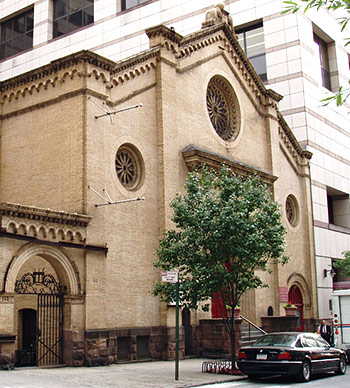
“one of the most refined and intelligent church spaces in New York” ~ The New York Times
Built in 1893 by Josiah Cleveland Cady, architect of the old Metropolitan Opera House and the American Museum of Natural History
|
Office Address:
JUPITER SYMPHONY
155 West 68th Street, Suite 319
New York, NY 10023
admin@jupitersymphony.com
(212) 799-1259
 
Like our Facebook page to see photos, videos,
concert information and the latest news
Jupiter in the News
ConcertoNet
“knocked the socks off this listener...It was wondrous chamber music. And the three artists gave it the deserving excitement, volition and imagination.”
Harry Rolnick, ConcertoNet more...

“the performers were top notch”
“The homey church where these concerts take place, nestled on West 66th Street in the shadow of Lincoln Center, is an intimate and acoustically vibrant place for chamber music.”
Anthony Tommasini, The New York Times more...
Strad Magazine
“A finely forthright, fluent and expressive account of Haydn's Divertimento in E-flat major opened this programme of miscellaneous chamber music in a series known for adventurous programming.”
Dennis Rooney, Strad Magazine more...
ConcertoNet
“Mr.
Nygaard’s cadenza flowed down Mozart lanes and paths, each with
beautiful backgrounds. And at the very end, Mr. Nygaard brought forth
that martial major theme, like an unexpected gift.”
Harry Rolnick, ConcertoNet more...

“...the group’s efforts proved illuminating ...Brown played a
lovely, subtly virtuosic cadenza for Mozart’s Piano Concerto No. 24 by
Jens Nygaard, the ensemble’s founder, who died in 2001, but whose
fascination with rarities continues to drive its programming”
Allan Kozinn, The New York Times more...
|
As promised, here are the videos of John Field’s Divertissement No. 1 and Sir Hamilton Harty’s Piano Quintet. Fortuitously, our Jupiter musicians had the good sense to record the rehearsal in an impromptu decision, literally minutes before pressing the record button. Pianist Mackenzie Melemed (replacing Roman Rabinovich at the last minute) learned the music in 2 days! Bravo to him.
Both works are Irish rarities that were scheduled for the March 16 performances which had to be canceled because of the coronavirus epidemic. Even though the entire program could not be recorded because of technical issues, we are pleased to be able to share with you the 2 musical gems. Enjoy.
John FIELD Divertissement No. 1 H. 13
~ simply delicious piano quintet, alternately titled Rondeau Pastoral and better known in its version for solo piano, Twelve O’clock Rondo, on account of the 12 “chimes” at the end ~ by the creator of the Nocturne, which had a major influence on Chopin
We thank the University of Illinois (Champaign) for a copy of the Divertissement music.
Mackenzie Melemed piano
Abigel Kralik violin
Dechopol Kowintaweewat violin
Sarah Sung viola
Christine Lamprea cello
Sir Hamilton HARTY Piano Quintet in F Major Op. 12
~ in a lyrical Romantic idiom, with a distinct, breezy Irish-salted voice
Andrew Clements of the Guardian proclaimed the beautiful Quintet “a real discovery: a big, bold statement full of striking melodic ideas and intriguing harmonic shifts, which adds Brahms and Dvořák into Harty’s stylistic mix, together with Tchaikovsky in some passages.” There’s folk music charm as well, reminiscent of Percy Grainger—notably in the Scherzo (Vivace) with its folksy quirks and nonchalance, and the winding, pentatonic melody in the Lento.
Our gratitude to the Queen’s University Library in Belfast, Northern Ireland, for a copy of the autograph manuscript of the music. Much thanks, too, to Connor Brown for speedily creating a printed score and parts from Harty’s manuscript.
Mackenzie Melemed piano
Abigel Kralik violin
Dechopol Kowintaweewat violin
Sarah Sun viola
Christine Lamprea cello
I Allegro 0:00
II Vivace 10:43
III Lento 14:44
IV Allegro con brio 23:59
|
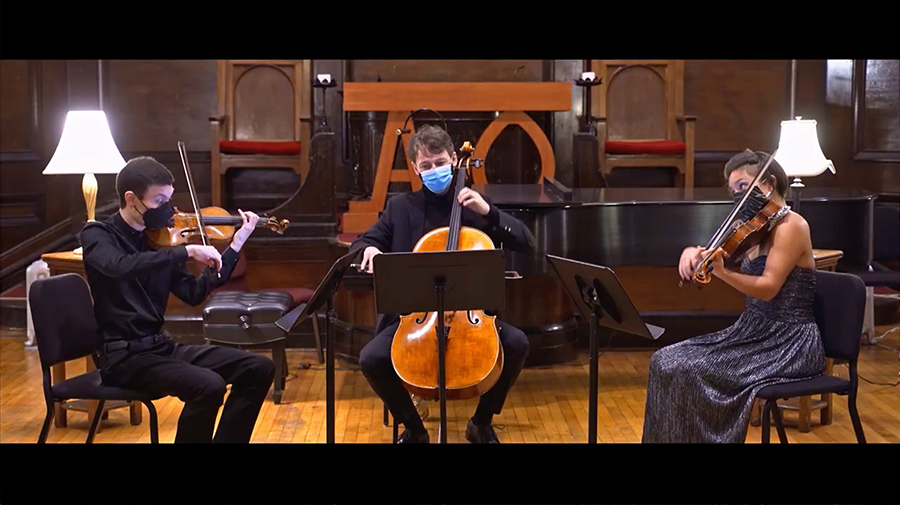
Oliver Neubauer violin, Mihai Marica cello, Zoe Martin-Doike viola
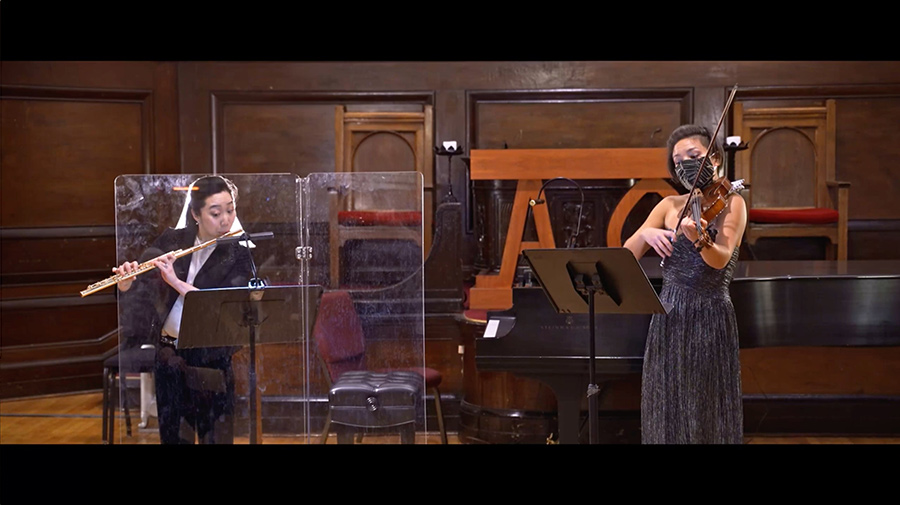
Sooyun Kim flute, Zoe Martin-Doike viola
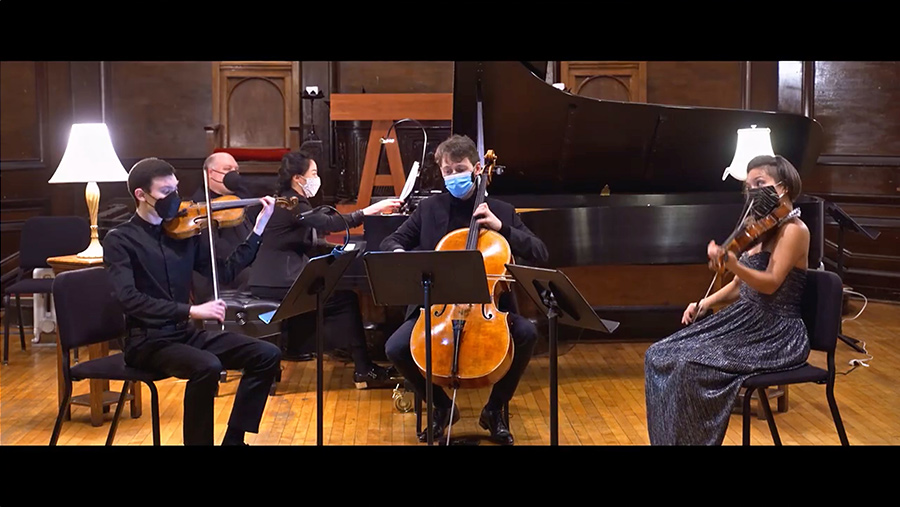
Oliver Neubauer violin, Janice Carissa piano
Mihai Marica cello, Zoe Martin-Doike viola
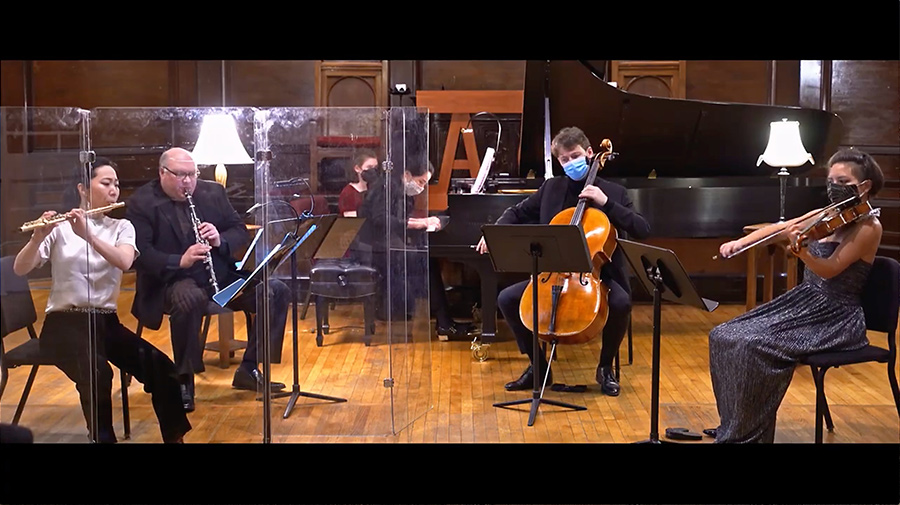
Sooyun Kim flute, Vadim Lando clarinet, Janice Carissa piano
Mihai Marica cello, Zoe Martin-Doike viola
|
Video Viewing ~ Classical Treats
February 8, 2021 Jupiter Concert
Greetings! Three months ago, our musicians brought warmth and joy with their wonderful music making on a cold, winter’s day with Classical Treats. The viewing is offered for $25, and we hope to cover the costs of production. Thanks so much for viewing the video of this concert, and for supporting Jupiter with gifts as well! MeiYing
View the video for $25
You will be automatically directed to the video page once payment is made. If not, click on the “return to merchant” link after checkout. Please go through the checkout process only once and do not use the back button or reload the page while making the purchase. If there are any problems, contact jupiternews@jupitersymphony.com.
Viewers comments of previous videos:
“Oh I thoroughly enjoyed the concert. Good to see Maxim and his dad. Familiar faces to me. I enjoyed the notes about the players. Till the next time...”
“Great playing and really nice camera work. Probably better than being there!”
“We so enjoyed the concert. The pianist was outstanding as was the musical selection.”
“It was wonderful. Thank you.”
♦ ♦ ♦
Musicians
Janice Carissa piano
Young Scholar of the Lang Lang Foundation, recipient of the 2018 Salon de Virtuosi Grant, winner of the 2014 piano competition at the Aspen Festival, and a top prizewinner of the IBLA Foundation’s 2006 piano competition (at age 8)
Oliver Neubauer violin
Recipient of the Gold Award at the 2018 National YoungArts Competition and winner of the 2017 Young Musicians Competition at the Chamber Music Society of Lincoln Center
Zoë Martin-Doike viola
Member of the Metropolitan Opera Orchestra, top prizewinner of the Primrose and Lenox competitions on viola and violin, respectively and founding violinist of the Aizuri Quartet
Mihai Marica cello
Winner of the Irving Klein, Viña del Mar, Salon de Virtuosi and Dotzauer competitions ~ “Mihai is a brilliant cellist and interpreter of music. His playing is spellbinding.” Mitchell Sardou Klein
Sooyun Kim flute
Winner of the Georg Solti Foundation Career Grant and a top prize at the ARD flute competition, she has been praised for her “vivid tone colors” by the Oregonian and as a “rare virtuoso of the flute” by Libération
Vadim Lando clarinet
Winner of the CMC Canada, Yale and Stonybrook competitions ~ “consistently
distinguished...vibrant, precise, virtuosic playing” The New York Times
♦ ♦ ♦
Program
HAYDN Sonata No. 1 in G Major Hob XVI:40 ▪ 1784
~ sophisticated and subtly wrought, the Sonata is from a set of 3, arranged for string trio from the original for keyboard and published by Johann André in 1790
The sonatas were written for Princess Marie, the new bride of Prince Nicholas Esterházy, grandson of Haydn’s employer, Prince Nicholas I. Cramer’s Magazin der Musik, in its review in 1785, observed that they were “more difficult to perform than one initially believes. They demand the utmost precision, and much delicacy in performance.” In 2 contrasting movements, the pastoral Allegretto innocente is followed by a gleeful zany romp.
Conradin KREUTZER Quintet in A Major ▪ between 1810 and 1820
~ in the late Classical–early Romantic style, the charming Quintet is written for the unusual combination of piano, flute, clarinet, viola, and cello with the piano as primus inter pares, first among equals—each movement a winner bearing a variety of melodic gifts and revealing a lively feeling for rhythm and color
Born in Messkirch to a respected Swabian burgher, Kreutzer (1780–1849) is considered a minor master of the Biedermeier epoch. He studied law in Freiburg before turning entirely to music after his father died in 1800. In 1804 he went to Vienna, where he met Haydn and probably studied with Albrechtsberger, one of Beethoven’s teachers. His active career included tours in Europe and several posts in Vienna, Stuttgart, Cologne, and other German cities, all the while composing numerous operas. Some of his music is not entirely forgotten—his settings for male chorus to Ludwig Uhland’s poems long remained popular with German and Austrian choirs; Das Nachtlager in Granada used to be revived occasionally in Germany; and his score for Der Verschwender continues to be performed in Austria.
Franz Anton HOFFMEISTER Duo Concertante No. 1 in G Major ▪ [1790]
flute and viola
1st movement ~ Allegro
~ by Mozart’s friend and his principal publisher
MOZART Piano Quartet No. 2 in Eb Major K. 493 ▪ 1786
~ a flawless masterpiece of utmost lightness and charm, with heavenly melodies
Mozart was under contract with the publisher Franz Anton Hoffmeister to write 3 piano quartets, a virtually new genre of his own invention. When the first (K. 478 in G minor) did not sell because of its difficulty for amateurs, Mozart was released from his obligation. Nine months later, which was two months after the completion of Le Nozze di Figaro, the second piano quartet (K. 493 in Eb Major) was published by Artaria. A little easier than the first, Alfred Einstein viewed it as “bright in color, but iridescent, with hints of darker shades.”
♦ ♦ ♦
Harry Munz audio engineer
Marc Basch videographer
For more about the musicians: guest artists • players
For further notes on the music: calendar |
|
